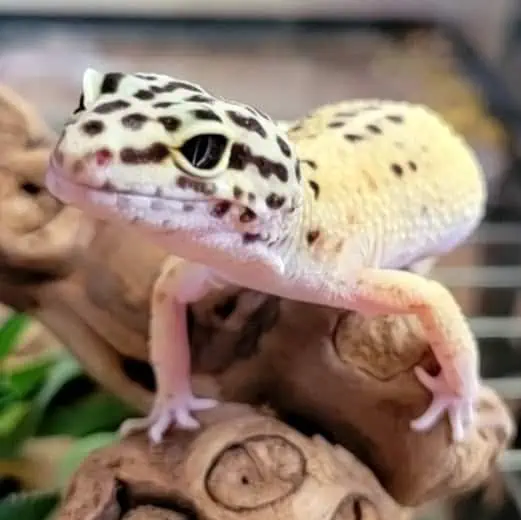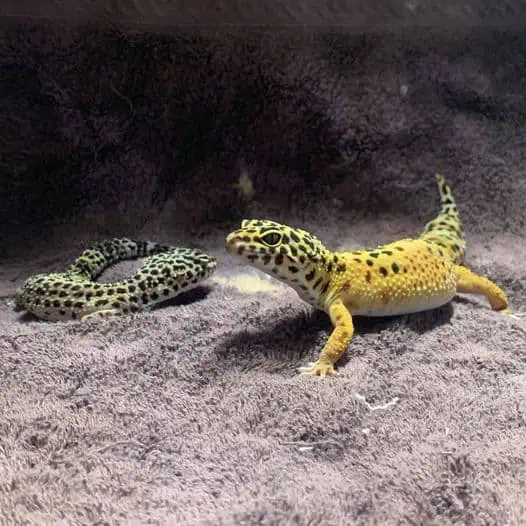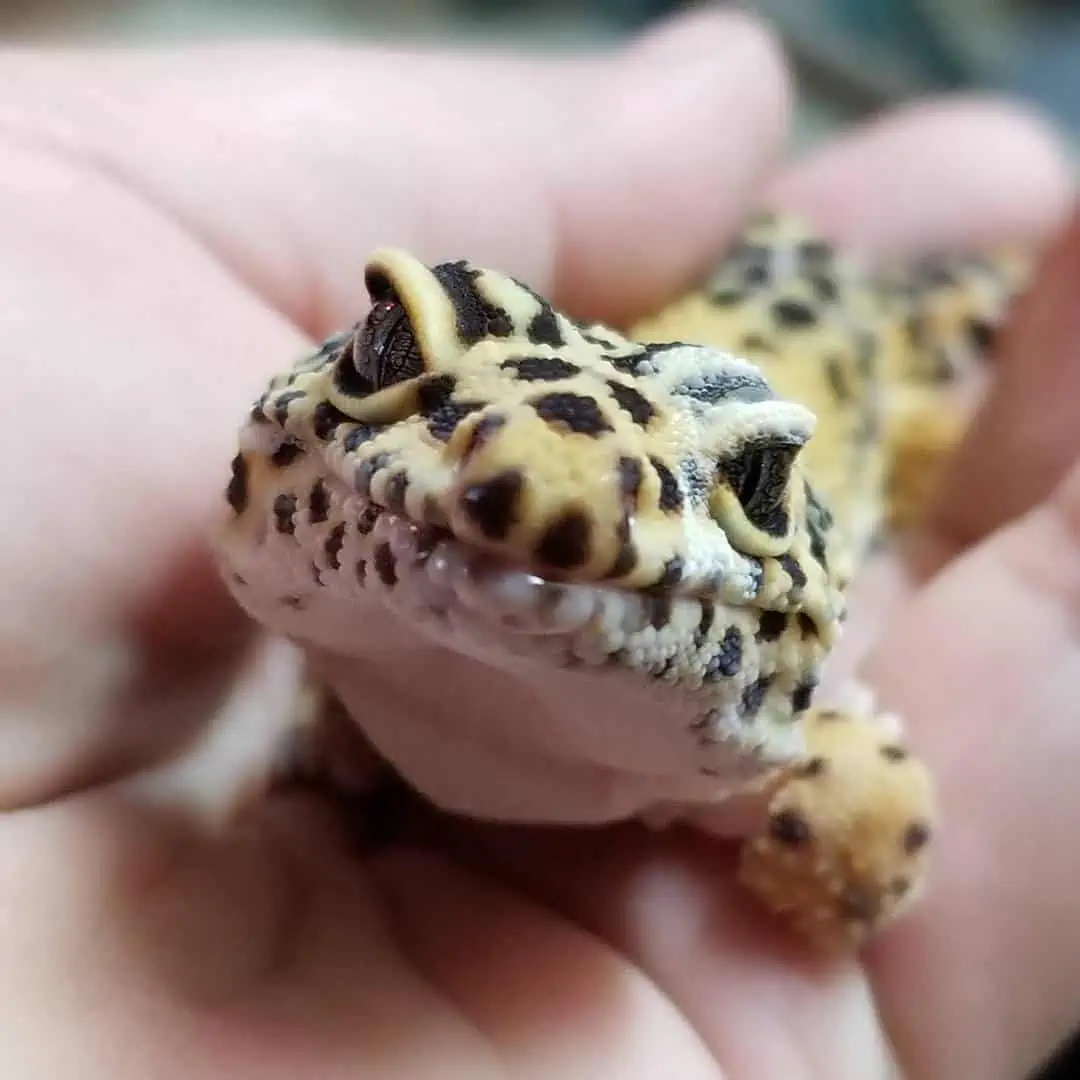Metabolic bone disease (MBD) is one of the worst illnesses to affect leopard geckos for several reasons.
- MBD is a debilitating and potentially fatal condition.
- It is sneaky and can go unnoticed at first.
- Even when cured, many of its consequences are irreversible, for good.
Luckily, Metabolic bone disease is not contagious, and it is perfectly preventable. That is why it is sad that it remains among the most prevalent diseases in leopard geckos due to a lack of proper care and information.
Today, I’m here to contribute to stopping the metabolic bone disease in leopard geckos, hopefully once and for all.
Knowledge and dedication to providing good care for our animals are the best preventive weapons against it, so – let’s start learning.
What Causes Metabolic Bone Disease in Leopard Geckos?
MBD is not just a simple bone disease – it is a metabolic disorder that affects mostly bones and occurs because of nutrient deficiency.
Calcium Deficiency
Most commonly, MBD is triggered by the lack of calcium that makes up the bones and renders them firm – but is also involved in many other physiological processes.
These “many others” are the key to MBD bone weakness and why it can happen even in fully developed individuals. Because the cells need calcium to function, if it is not provided through diet, the body will retract it for bones. In time, these calcium-deprived bones become weak and brittle.
Vitamin D3 Deficiency
The body needs vitamin D3 to be able to absorb calcium in the first place. Reptiles (and humans, for that matter) synthesize Vitamin D3 when exposed to UV rays from sunlight. No Vit D3 – no calcium absorption, even if there is enough calcium in the diet itself.
In captivity, reptiles receive Vitamin D3 through exposure to UVB tank lights or nutritional supplements (multivitamins usually contain enough), and calcium comes from food and direct supplements such as calcium powder or finely ground cuttlefish bone.
Other Causes of MBD
More rarely, the issue with other nutrients can also cause imbalance leading to MBD. Too much phosphorus can interfere with calcium absorption and cause MBD despite the calcium being provided at the right doses. The right calcium-to-phosphorus ratio in the leopard gecko diet is 2:1
Additionally, MBD can occur due to low ambient temperature in the tank, as it interferes with the lizard’s ability to digest food and absorb nutrients – even if you ensure their content is sufficient.

Why Does Metabolic Disease Occur?
In its essence, the metabolic bone disease is the consequence of captive conditions. The animals have limited access to natural sunlight, food items, and minerals from the environment, and all these elements are essential to keep their metabolism healthy.
- The sunlight helps turn cholesterol in the skin into Vitamin D3, and this substance drives the absorption of calcium essential for strong bones and proper metabolism.
- A varied diet and various mineral debris in the soil and on rocks randomly ingested by wild geckos ensure additional nutrient intake.
- They are adapted to environmental conditions, meaning they can keep their body temperature at an optimal level at all times.
In captivity, leos have limited, or no access to sunlight, and their choice of insects is poor and reduced to two or three species (in some cases, even just one), and due to impaction risks, there should be no loose gravel, sand, or similar ingestible substrate. Their proper nutrient intake depends on artificial products – reptile vitamin supplements and UVB lighting.
This is where the owner’s responsibility comes into play.
Due to misinformation, tough life circumstances, or plain and simple – irresponsibility, leos can end up on an unvaried diet with inadequate supplementation and generally poor living conditions.
That, my friends, is a recipe for disaster – spelled as “metabolic bone disease.”
There are two especially MBD-risky groups of leopard geckos:
- Baby and juvenile leos (due to active growth)
- Gravid females (due to spending large amounts of calcium on egg formation)
However, leos can be at risk of MBD or other reptile diseases at any age when care is not right.
Is Metabolic Bone Disease Fatal?
In all reptiles, metabolic bone disease is progressive and eventually fatal if not addressed. Only the beginning stages can be helped by the owner alone. The advanced stages must be treated by a reptile vet to avoid a deadly outcome.
However, it’s not just about surviving MBD – there is also a matter of quality of life.
Even for survivors, the level of deformation, wasting, and nerve damage can be so severe that there is just no point in keeping the suffering animals alive. Experienced vets say that extensive nerve damage is the worst-case scenario for MBD and the predictor of a poor outcome.
In tough cases, the vet often recommends euthanasia. However, be aware that the decision of whether to euthanize your pet is up to you. I recommend informing yourself well about reptile euthanasia first, as it is not as gentle as the phrase “putting to sleep” may imply.
Also, when making the call, try to find out in detail if the gecko is in pain – keeping an animal alive in chronic pain just out of our sentimentality is cruel. On the other hand, if a leo seems not to be in pain but it is challenging to care for, euthanasia might not be needed if you oblige to meet all of its special needs.
How Does Metabolic Bone Disease Look Like in Leopard Geckos?
The classic metabolic bone disease symptoms in leopard geckos are the following.
Mobility Issues
Mobility issues are usually among the first signs of MBD and can happen before deformities appear. They manifest in two ways:
- Uncontrolled movement – shakiness, jerking, twitching, especially in the limbs, indicating neurological damage.
- Trouble moving – the affected leos may be reluctant to move and show lameness, the inability to lift the body off the ground, and even partial paralysis.
At the same time, these early MBD issues are also the standard calcium deficiency symptoms.
Leg Deformities
Legs become at first arched or bowed slightly, then become swollen, crooked, and develop bumps and fractures; fractures that heal wrongly make the legs even more deformed.
Crooked Spine
As the disease takes hold, the spine will become arched or develop lesions (swellings and bumps), making the whole body look distorted.
Note: Bumps that appear along the legs and spine are the body’s attempt to fix MBD.
Crooked Tail Tip
As leos have fat storage alongside the tail, usually only the tip of the tail can be visibly affected by MBD.
Distorted Jaw
Like other bones, those that make up the jaw are also affected by MBD, leading to deformations. Because the lower jaw retracts and may even become soft to the touch, the disease is sometimes called the “rubber jaw.” The jaw swellings are a disadvantage in MBD treatment because they make it harder for the lizard to consume food and nutrients.
Stuck shed
With MBD, the shed usually gets stuck on the lizard’s toe tips and the head.
Lack of appetite and wasting
Due to pain, jaw issues, and general weakness, the MBD-affected reptile may stop feeding, leading to anorexia. Leos with advanced cases of MBD will usually be thin and emaciated, with little or no tail fat storage.
Constipation
MBD interferes with the consumption and digestion of prey, and the sick leo might have trouble passing stool or not defecate at all (obstipation).

Is Metabolic Bone Disease Hard to Discover?
One of the problems is that the early signs of MBD are very discrete and are easily missed.
At first, non-conclusive symptoms such as lethargy or anorexia may appear, or the affected leopard gecko may start walking weirdly and become shaky. That is why it is important to watch over your leo’s behavior at all times because something as banal as reluctance to move might lead to an MBD diagnosis in the end.
When the front limbs become deformed, it will happen only slightly at first. The curve will look strange like the arm was made of rubber. However, the change is quite easy to overlook, especially in long and lanky juveniles or skinny adult geckos.
Only as the disease progresses do the deformities become more apparent, especially if fractures are involved, however, by this time, the damage is much harder to reverse.
Can I Check Calcium Sacks to Diagnose MBD in Leopard Gecks?
You may have heard that geckos have calcium sacs – the structures on the upper roof of their mouths that store calcium. Thus, calcium deficiency can be determined by visually inspecting the sacs.
However, leopard geckos do not have calcium sacs, so this is not an option for diagnosing calcium deficiency or MBD diagnosis in leos.
Diagnosing Metabolic Bone Disease in Leopard Geckos
The metabolic bone disease can be easily diagnosed by a beginner hobbyist only in the advanced cases – but by that time, it is too late to hope for a full disease reversal.
The only way to diagnose early MBD with certainty is a reptile vet check. A full-body X-ray can reveal bone weakness even before lesions or fractures occur.
Due to the risk of buying a juvenile leo that may have a “silent” case of MBD, I would advise you to bring any new animal to a specialized vet check-up.
Can You Reverse Metabolic Bone Disease?
Metabolic bone disease can be reversed if caught early before much damage occurs. In advanced cases, it is “reversible” in the sense of stopping further progression, but the consequences remain. The bones may regain some of their strength but will remain deformed; other organs and nerves might also be damaged.
Also, the level of deformation in key points – for example, the jaw – might make the treatment harder as the lizard won’t be able to eat properly (and thus consume the needed nutrients).
The success of MBD treatment depends on how early you catch it and how fast you act. When it comes to acting, it is crucial to find professional help in the form of an experienced reptile or exotics vet.
Treating the advanced cases of MBD yourself is something I would never recommend, as it requires special intensive treatments (you may have to leave your leo at the vet).
Like with many other diseases, prevention is the best “treatment” for MBD.
How to Treat Metabolic Bone Disease in Leopard Geckos
The first line of both prevention and treatment of MBD is providing the right calcium and Vitamin D3 supplementation and a varied diet. This includes:
- Gut-loading insects with calcium-rich plant food.
- Dusting the insects with calcium powder and a Vit D3-containing multivitamin interchangeably.
- Keeping the pure calcium or Low-D3 calcium supplement in a cap in the tank available at all times.
- Ensuring the correct Vitamin D3 levels through supplementation, as well as UVB lighting if you decide it’s a good choice for you (the question of whether leos need it is still highly debated).
To learn more about proper leopard gecko calcium and vitamin supplementation and the quality options out there, head to our Leopard Gecko Calcium and Vitamins article.
The advanced cases of MBD need to be treated by a reptile vet. Treatment choice will depend on the case and the vet but may include vitamin injections, UVB exposure, and other supplemental methods.
The good news is that MBD can be stopped, and your pet can live a long and happy life, even as a survivor. However, if you intend to cure your leo of MBD, please follow the doctor’s advice closely!
How Long Does It Take to Reverse Metabolic Bone Disease?
How long it takes to make MBD better or go away will depend on the severity of the case and the provided care.
However, the short generalized answer would be that it takes weeks and months in advanced cases.
Early MBD cases caught in time and treated with a proper nutrient regiment should improve in about one month. If the symptoms continue to advance, don’t wait it out – consult a vet for help.
Take Care of your Leo
I hope you now know how dangerous and painful metabolic bone disease can be for our precious leopard geckos. I also hope that you realize it is not a case of bad luck but completely the owners’ responsibility to prevent it from happening or to treat it.
The good news is that if you just manage to stick to reliable advice on leopard gecko care – and perhaps invest in that first-timer veterinary check-up – you will never have to face the horrors of MBD. I promise it’s not hard to do – all the information is out there, so it just takes love and dedication. And those smiling leo faces are hard not to adore!
Anything to add about the metabolic bone disease in leos? Anything to ask? Spare a moment and write a comment below. Both your experiences and your questions are immensely valuable to the community!



4 Comments
I’m sad to say we discovered this evening our Leo has MBD and unfortunately I’m at a loss. She has a big fat tail and has seemed totally fine. This evening we were cleaning her cage and noticed it looked like she was army crawling and I was completely shook. We used to get her out and handle her often but mostly only admire her in her aquarium now. So having not get her out as much we missed this. She’s continued to eat and use the bathroom just fine, another reason we probably haven’t noticed is she’s mostly out wondering around at night and we are sleeping at the time. There aren’t any exotic vets close to us and I’m at a loss on what to do. With the army crawl I’m afraid her bones have already broken and how the heck do we tell. I’m distraught and so upset. I don’t want her to be in pain or suffering but I have not a clue what to do right now.
Hi Sabs,
I’m so sorry if MBD is the case. It would be best if the vet could confirm or dismiss your suspicions, but if that’s not an option, keep observing for other signs.
However, if MBD is the case, my guess is that you’ve caught it early enough to treat it.
The fact that the tail is plump and she’s eating well doesn’t mean she’s getting all the nutrients she needs, so now might be a good time to dive into that. Do you provide regular multivitamin (with D3) supplementation, with pure calcium powder available in her cage? Please read our Leopard Gecko Diet and Leopard Gecko Supplementation articles to check if you could improve anything.
Another thing I would definitely recommend is getting a 5% T5 UVB light if you don’t have one. Arcadia Shadedweller is one of the most reccomended bulbs for leos, but there are several options on the market. Please see this neat visual guide to check what the right distance is for what type of bulb.
Again, check in with a reptile vet when you get a chance, even if online.
To conclude, please don’t be ridden with guilt. MBD can be a really sneaky disease, but if caught early, it is treatable – remember that. Good luck!
Our Leo has only showed jaw issues which we assume is caused by MBD, she is otherwise healthy looking, good fat tail, limbs all look normal, she moves well and holds her weight (stands tall). We recently discovered that her heating mat had been playing up so have changed that and have been trying to get calcium into her on her food. She manages to eat a small soft worm ok, but then when attempting to eat a 2nd she struggles to grab it into her mouth. After trying time and time again its like her tongue gets stuck or swells and looks uncomfortable. Are we on the right track with treating her for MBD or are these symptoms something else? We unfortunately live in an area with limited vet experience for exotics like our Leo, so it is not easy to get vet help for her. We would need to drive 3 hours out of town to a main center for vet help.
Hi Deirdre,
You’ve mentioned calcium, but not other minerals or vitamins – most importantly D3. As I mentioned in multiple articles here – the one above, the one on leo diet, and the one on leo supplementation – all lizards need vitamin D3 to metabolize calcium they ingest. Calcium supplements without any Vit D3 won’t work. If you seriously suspect MBD, consider including a UVB light to speed up recovery.
On the other hand, your leo could be suffereing from another jaw problem unrelated to MBD, such as a hidden abscess, a deformity, or an infection in the mouth. However, a check-up would be needed to determine the exact cause. I understand that your vet options are limited, but life is definitely worth a 3 hour drive, right?